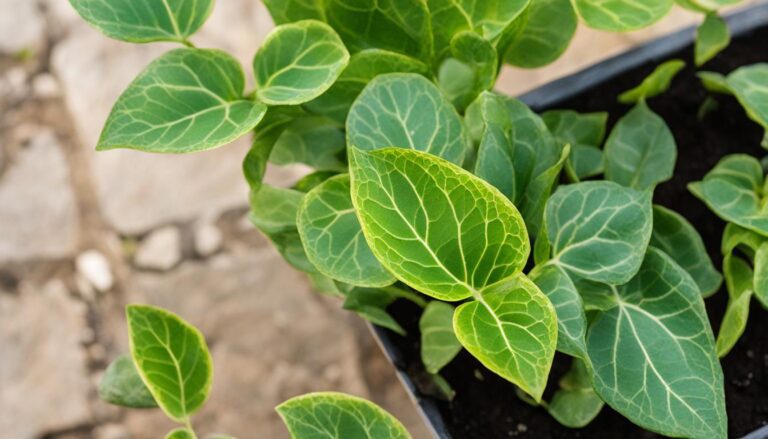
Growing healthy plants requires a delicate balance of nutrients, and phosphorus is a key player in their growth and development. If you’ve noticed your plants struggling or showing signs of nutrient deficiencies, such as stunted growth or yellowing leaves, it might be time to boost their phosphorus levels. In this section, I will share some effective methods to increase phosphorus in plants and help them thrive.
Key Takeaways:
- Phosphorus is an essential nutrient for plant growth and plays a crucial role in root development, photosynthesis, and overall plant health.
- Factors like over-fertilization, soil compaction, and herbicide injury can hinder phosphorus uptake by plants, leading to deficiencies.
- Adding phosphorus to the soil can be done through various methods, including using fertilizers with a high phosphorus content or utilizing organic sources like bone meal and fish meal.
- The timing and method of phosphorus application are important for optimal results. It’s recommended to add phosphorus to the soil before planting or during the growing season for existing plants.
- Proper phosphorus management is crucial to avoid nutrient imbalances or environmental pollution. Regular soil testing and monitoring plant health can guide phosphorus management decisions.
Understanding Phosphorus and its Importance in Plant Growth
Phosphorus is an essential nutrient for plant growth, playing a crucial role in various aspects of their development. Along with nitrogen and potassium, phosphorus is one of the three main nutrients needed by plants. It is involved in early root growth, seed development, winter hardiness, and water efficiency.
Phosphorus supports photosynthesis and the production of chlorophyll, which gives plants their green color.
A deficiency in phosphorus can have detrimental effects on plant growth. It can result in stunted growth, weak stems, discoloration of leaves, and poor harvests. Therefore, it is important to understand the significance of phosphorus and its role in plant development.
Phosphorus uptake in plants occurs through the roots, where it is absorbed and transported to various parts of the plant. Once absorbed, phosphorus is used in energy transfer reactions, DNA and RNA synthesis, and the synthesis of proteins and enzymes.
By ensuring an adequate supply of phosphorus, we can promote healthy plant growth and optimize their nutrient efficiency.
Importance of Phosphorus Fertilizer and Phosphorus-Rich Plant Foods
To provide plants with sufficient phosphorus, it is necessary to use phosphorus fertilizers or incorporate phosphorus-rich plant foods into the soil.
Phosphorus fertilizers come in different forms, such as phosphorus-containing compounds like monoammonium phosphate (MAP) or diammonium phosphate (DAP). These fertilizers provide plants with readily available phosphorus, ensuring its quick uptake and utilization.
Alternatively, phosphorus-rich plant foods, such as bone meal or rock phosphate, can be used to supplement phosphorus levels in the soil.
These organic sources slowly release phosphorus over time, ensuring a continuous supply for plant growth. It is important to choose the appropriate phosphorus fertilizer or organic source based on the specific needs of your plants and soil conditions.
By understanding the importance of phosphorus and utilizing the right fertilizers or organic sources, we can support healthy plant growth and optimize their nutrient uptake.
In the following sections, we will explore different methods of adding phosphorus to the soil and discuss their benefits and best practices.
| Phosphorus Fertilizer | Phosphorus-Rich Plant Foods |
|---|---|
| Provides readily available phosphorus | Slowly releases phosphorus over time |
| Quick uptake by plants | Continuous supply of phosphorus |
| Choose based on specific plant and soil needs | Suitable for organic gardening |
Adding Phosphorus to the Soil
Increasing phosphorus levels in the soil is crucial for promoting healthy plant growth and addressing phosphorus deficiencies. There are various methods available to improve phosphorus availability and ensure optimal plant development.
One approach is to use a fertilizer with a high phosphorus content, such as a 10-20-5 NPK ratio. These fertilizers can be applied directly to the soil, providing an immediate source of phosphorus for plants.
Another effective method for adding phosphorus to the soil is through the use of soil conditioners. These conditioners can help release phosphorus that is bound up in the soil, making it more accessible to plants.
Soil conditioners can be applied during soil preparation or incorporated into the soil surface around established plants.
Table: Comparison of Phosphorus Adding Methods
| Method | Advantages | Disadvantages |
|---|---|---|
| Fertilizers with high phosphorus content | Immediate source of phosphorus | May require repeated application |
| Soil conditioners | Increases phosphorus availability | May take time to release phosphorus |
Before deciding on the method to add phosphorus to the soil, conducting a soil test is essential. This test can help determine the current phosphorus levels in the soil and identify any underlying issues affecting phosphorus uptake.
With the results of the soil test, gardeners can make informed decisions about the most effective approach to increasing phosphorus levels in the soil.
Using Organic Sources of Phosphorus
When it comes to boosting phosphorus levels in the soil, organic sources can be a great option. Not only do they provide the necessary nutrient for plant growth, but they also contribute to the overall health and fertility of the soil.
Organic phosphorus sources offer several advantages over synthetic fertilizers, such as being more environmentally friendly and promoting long-term soil health.
One popular organic source of phosphorus is bone meal. Made from steamed animal bones, bone meal is a natural fertilizer that is rich in phosphorus.
It releases phosphorus slowly, providing a steady supply to plants over time. Another option is rock phosphate, a mined rock that contains up to 20% phosphorus. Rock phosphate is a slow-release fertilizer, making it ideal for providing a long-term source of phosphorus to plants.
Fish meal is another effective organic source of phosphorus. Derived from the byproducts of the fishing industry, fish meal is a nutrient-dense fertilizer that can enhance phosphorus levels in the soil.
Green manure crops and animal manure can be used to supplement phosphorus naturally. These organic materials not only contribute phosphorus but also improve soil structure and fertility.
The Benefits of Using Organic Sources
Using organic sources of phosphorus offers several benefits for both plants and the environment. These sources provide a slow and steady release of phosphorus, ensuring that plants have a constant supply of this essential nutrient.
Organic fertilizers also improve soil health by promoting microbial activity and enhancing nutrient cycling. They help to retain moisture in the soil, reduce erosion, and increase soil fertility over time.
Furthermore, organic sources of phosphorus are environmentally friendly. Unlike synthetic fertilizers, they do not contain harmful chemicals that can leach into groundwater or cause pollution. They are also sustainable and renewable, making them a more responsible choice for gardeners and farmers.
Organic sources of phosphorus are a valuable addition to any garden or farm. They provide a natural and sustainable way to boost phosphorus levels in the soil, promoting healthy plant growth and improving overall soil fertility.
Whether it’s bone meal, rock phosphate, fish meal, or organic manures, these sources offer numerous benefits for both plants and the environment.
By incorporating organic phosphorus sources into your gardening practices, you can enhance the health and productivity of your plants while minimizing your environmental impact.
When and How to Apply Phosphorus

Adding phosphorus to the soil at the right time and in the right way is essential for maximizing its effectiveness and promoting optimal plant growth.
The best time to apply phosphorus is typically 1 to 2 weeks before planting. This allows enough time for the phosphorus to be released and absorbed by the plants, giving them a head start in nutrient uptake. However, phosphorus can also be applied during the growing season to give existing plants a boost.
When applying phosphorus, it is important to mix it into the soil without disturbing the plant roots. This can be done by gently raking the phosphorus into the top layer of soil or using a hoe to lightly incorporate it.
It is also recommended to water the area thoroughly after application to ensure that the phosphorus is evenly distributed and readily available to the plants.
There are various forms of phosphorus that can be used for application, including compost, bone meal, and rock phosphate. Each form has its own benefits and may be suitable for different soil types or specific plant requirements.
It is important to follow the recommended application rates as specified on the product packaging or based on soil test results. By applying phosphorus correctly, you can ensure that your plants have access to this vital nutrient and promote healthy growth and development.
- The best time to apply phosphorus is 1 to 2 weeks before planting.
- Apply phosphorus without disturbing the plant roots.
- Water the area thoroughly after application.
- Choose the appropriate form of phosphorus based on soil type and plant requirements.
- Follow recommended application rates for optimal results.
Comparison of Different Forms of Phosphorus
| Form of Phosphorus | Benefits | Application |
|---|---|---|
| Compost | Slow-release nutrient supply | Spread evenly over the soil surface before planting or as a top dressing during the growing season |
| Bone Meal | Rich source of phosphorus | Incorporate into the soil before planting or sprinkle around established plants |
| Rock Phosphate | Slow-release phosphorus over an extended period | Apply directly to the soil before planting or incorporate into the soil |
Benefits of Adding Phosphorus to the Soil
Adding phosphorus to the soil can have numerous benefits for plant growth and overall soil health. In this section, I will highlight some of the key advantages of supplementing phosphorus levels in your garden or agricultural fields.
Enhanced Plant Growth and Phosphorus Absorption
Phosphorus is critical for the development of strong and healthy plant roots. When phosphorus levels are adequate, plants are better able to absorb other essential nutrients, such as nitrogen and potassium.
This leads to improved overall plant growth, including increased foliage, stronger stems, and higher yields.
Additionally, phosphorus plays a vital role in energy transfer within the plant, facilitating photosynthesis and the production of adenosine triphosphate (ATP), which is essential for cellular energy.
This ensures optimal plant function, allowing them to efficiently utilize available resources and better withstand environmental stresses.
Improved Soil Fertility and Sustainability
Phosphorus is an integral component of soil fertility. By adding phosphorus to the soil, you can replenish nutrient reserves and maintain a balanced soil ecosystem.
Adequate phosphorus levels promote microbial activity and enhance soil structure, resulting in improved water infiltration and nutrient availability for plants.
Furthermore, phosphorus helps to facilitate nutrient cycling in the soil, allowing for the efficient use of organic matter and reducing the risk of nutrient runoff and leaching.
This contributes to sustainable agriculture practices and helps to protect water quality in nearby aquatic ecosystems.
Increased Resistance to Stress and Disease
Phosphorus is closely linked to the production of plant hormones and compounds that enhance stress tolerance. Adequate phosphorus levels help plants cope with environmental challenges such as drought, extreme temperatures, and nutrient imbalances. They also strengthen plant cell walls, making them more resilient against fungal and bacterial infections.
Higher Quality and Nutrient Content in Crops
Phosphorus is a key component in the synthesis of proteins, enzymes, and vitamins in plants. By ensuring optimal phosphorus levels, you can improve the nutritional quality of your crops.
This is particularly important for food crops, as higher phosphorus levels can enhance the content of essential nutrients such as iron, zinc, and vitamin C.
In summary, adding phosphorus to the soil provides numerous benefits, including enhanced plant growth and nutrient absorption, improved soil fertility and sustainability, increased resistance to stress and disease, and higher quality and nutrient content in crops.
By carefully managing phosphorus levels, you can optimize your plant’s health and achieve more productive and sustainable agricultural practices.
| Benefits of Adding Phosphorus to the Soil |
|---|
| Enhanced plant growth and phosphorus absorption |
| Improved soil fertility and sustainability |
| Increased resistance to stress and disease |
| Higher quality and nutrient content in crops |
Utilizing Phosphorus in Different Types of Soils
Improving phosphorus availability in different soil types is crucial for promoting healthy plant growth and maximizing nutrient uptake. The availability of phosphorus can vary depending on the composition of the soil.
Heavy clay soils, for example, tend to have lower phosphorus availability due to their compact nature, which hinders the movement of nutrients. Sandy soils, on the other hand, may naturally have better phosphorus availability but can still benefit from additional supplementation.
To improve phosphorus availability in heavy clay soils, it is essential to use phosphorus-rich fertilizers and soil amendments. These products can help release the bound phosphorus, making it more accessible to plants.
Organic sources such as bone meal and rock phosphate are effective options for increasing phosphorus levels in these soils. Incorporating organic matter into the soil can improve its structure and nutrient-holding capacity, enhancing phosphorus availability.
In sandy soils with better phosphorus availability, applying phosphorus-rich fertilizers can further enhance plant growth. Slow-release fertilizers that provide a steady supply of phosphorus over time are particularly useful in these soils.
Regular soil testing can help determine the specific phosphorus requirements of sandy soils and guide the application of phosphorus fertilizers at the right time and in appropriate amounts.
Promoting Phosphorus Availability in Different Soil Types
To ensure optimal phosphorus availability in both clay and sandy soils, it is essential to maintain proper soil pH. Phosphorus availability is highest in slightly acidic to neutral soils, with a pH range of 6.0 to 7.0.
Conducting a soil test can help identify the pH level of the soil and determine if any adjustments are necessary.
In addition to pH management, incorporating organic matter into the soil can improve phosphorus availability in all soil types.
Organic matter acts as a reservoir for nutrients, including phosphorus, and slowly releases them to plant roots. This can enhance nutrient uptake and contribute to overall plant health.
By understanding the specific characteristics of different soil types and implementing appropriate strategies, gardeners and farmers can improve phosphorus availability and support healthy plant growth.
Whether it’s through the use of phosphorus-rich fertilizers, organic amendments, or pH management, optimizing phosphorus levels can lead to more productive and resilient plants.
Importance of Proper Phosphorus Management
As a gardener, I understand the critical role that phosphorus plays in promoting healthy plant growth. It’s important to manage phosphorus properly to ensure optimal results and minimize negative impacts on the environment.
By following some best practices for phosphorus application, I can ensure that my plants receive the necessary nutrients without causing harm.
One of the key considerations in phosphorus management is avoiding over-application. Applying excessive amounts of phosphorus can lead to nutrient imbalances, which may hinder plant growth and result in environmental pollution.
To prevent this, I make sure to follow recommended application rates based on soil test results. This helps me tailor the phosphorus application to the specific needs of my garden.
On the other hand, under-application of phosphorus can lead to nutrient deficiencies and decreased plant performance. To avoid this, I regularly monitor my plants for any signs of phosphorus deficiency, such as stunted growth or discoloration of leaves.
If needed, I adjust the phosphorus application to ensure that my plants receive adequate amounts of this essential nutrient.
Regular soil testing is another crucial aspect of phosphorus management. By testing my soil periodically, I can determine the existing phosphorus levels and make informed decisions about the need for supplementation.
Soil testing also helps me understand the specific requirements of different areas in my garden, allowing me to target phosphorus application more effectively.
In summary, proper phosphorus management is vital for maintaining healthy plant growth and nutrient efficiency in gardening.
By avoiding over-application, monitoring for deficiencies, and conducting regular soil tests, I can ensure that my plants receive the right amount of phosphorus without harming the environment. This way, I can promote optimal plant nutrition and enjoy the fruits of my gardening efforts.
FAQ
How can I boost phosphorus levels in plants?
You can boost phosphorus levels in plants by applying a fertilizer with a high phosphorus content, using soil conditioners that release phosphorus bound in the soil, or using organic sources of phosphorus such as bone meal or rock phosphate.
What are the signs of phosphorus deficiency in plants?
Signs of phosphorus deficiency in plants include stunted growth, weak stems, discoloration of leaves, and poor harvests.
When is the best time to add phosphorus to the soil?
It is recommended to add phosphorus to the soil 1 to 2 weeks before planting for optimal results. However, phosphorus can also be applied during the growing season to give existing plants a boost.
What are some organic sources of phosphorus?
Organic sources of phosphorus include bone meal, rock phosphate, fish meal, green manure crops, and animal manure.
How can I improve phosphorus availability in different types of soils?
The availability of phosphorus can vary depending on soil types. For heavy clay soils, it may be necessary to supplement with additional phosphorus sources. Sandy soils can benefit from the addition of phosphorus-rich fertilizers.
What are the benefits of adding phosphorus to the soil?
Adding phosphorus to the soil promotes healthy root development, supports photosynthesis, improves overall plant growth and vigor, and increases resistance to stress.
How should I manage phosphorus properly?
Proper phosphorus management involves following recommended application rates and practices to ensure effective utilization by plants without causing harm to the environment. Regular soil testing and monitoring of plant health are important for making informed phosphorus management decisions.






